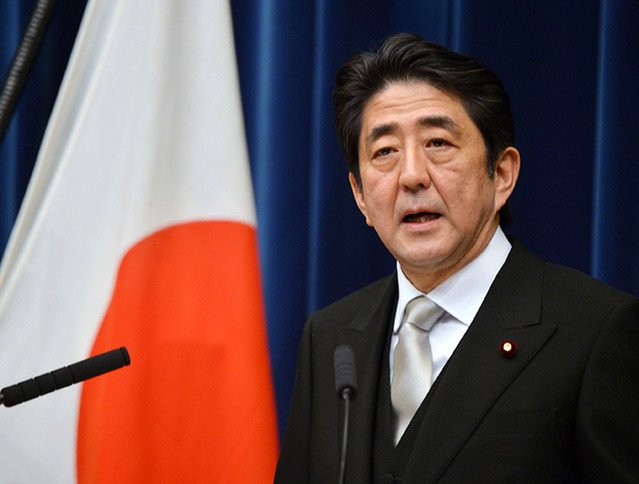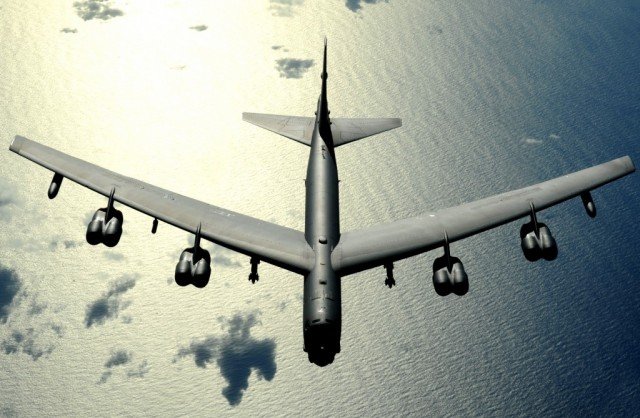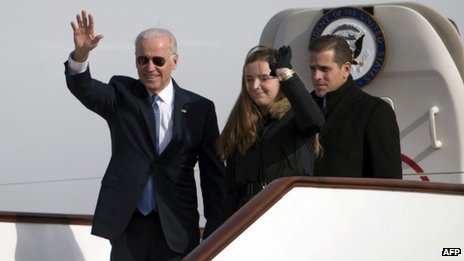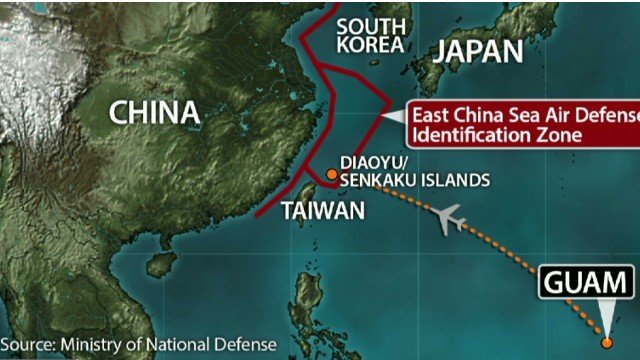Home Tags Posts tagged with "Air Defense Identification Zone"
Air Defense Identification Zone
Japan’s government has approved a new national security strategy and increased defense spending in a move widely seen as aimed at China.
Over the next five years, Japan will buy hardware including drones, aircraft and amphibious vehicles.
The military will also build a new marine unit, an amphibious force capable of retaking islands.
The move comes with Tokyo embroiled in a bitter row with Beijing over East China Sea islands that both claim.
It reflects concern over China’s growing assertiveness over its territorial claims and Beijing’s mounting defence spending.
“China’s stance toward other countries and military moves, coupled with a lack of transparency regarding its military and national security policies, represent a concern to Japan and the wider international community and require close watch,” the national security draft said.

PM Shinzo Abe has called for Japan to broaden the scope of activities performed by its military
Japan first increased defense spending in January, after a decade of cuts.
PM Shinzo Abe, who was elected a year ago, has called for Japan to broaden the scope of activities performed by its military – something currently tightly controlled by the post-war constitution.
He has also established a National Security Council that can oversee key issues.
Approving the national security strategy made Japan’s foreign and security policy “clear and transparent – for both the Japanese people and all the world to see”, he said.
The announcement comes weeks after China established an air defense identification zone (ADIZ) over a swathe of the East China Sea, including islands controlled by Japan.
It says all aircraft transiting the zone must obey certain rules, such as filing flight plans, or face “measures”.
Japan, US and South Korea – which claims a rock that lies within China’s declared zone – have strongly criticised the move, with the US calling it a unilateral attempt to change the status quo in the region.
China, meanwhile, says it is “closely watching Japan’s security strategy and policy direction”.
[youtube f-8exf7VU5M 650]
South Korea is expanding its air defense zone, which will now partially overlap with a similar zone announced by China.
The two zones will now both include a rock claimed by both countries and controlled by South Korea.
The defense ministry said it would co-ordinate with “related countries”.
China announced a new Air Defense Identification Zone (ADIZ) last month, in a move that raised regional tensions.
Both countries’ zones will cover the airspace above a rock called Ieodo by South Korea and Suyan by China, which is claimed by both countries.
As well as Ieodo rock, South Korea’s Defense Ministry also said the new military air defense zone would cover the airspace above Marado and Hongdo islands controlled by Seoul in waters south of the peninsula.
The new parameters are a direct challenge to China’s own air defense zone, which covers part of the same area.

South Korea is expanding its air defense zone, which will now partially overlap with a similar zone announced by China
South Korea said its zone would take effect on December 15, and that neighboring countries had already been notified of the change.
The government would continue to consult with neighboring countries to stop accidental military clashes, it said.
“We will co-ordinate with related countries to fend off accidental military confrontations and to ensure safety of airplanes,” defense ministry spokesman Kim Min-seok told the AFP news agency on Sunday.
South Korea has already challenged China’s attempt to impose its authority in the area by flying military planes through the zone announced by Beijing.
Commercial airlines in South Korea have also been advised not to comply with China’s demands for planes to identify themselves to it.
The US and Japan have also rejected China’s zone and flown undeclared military aircraft through the zone.
It will be the first time that South Korea has adjusted the zone since it was first set up by the US military in 1951 during the Korean War, South Korea’s Yonhap news agency reports.
China’s recently announced ADIZ also covers islands claimed and controlled by Japan.
China said aircraft flying through the zone must follow its rules, including filing flight plans.
What are air defense identification zones?
- Zones do not necessarily overlap with airspace, sovereign territory or territorial claims
- States define zones, and stipulate rules that aircraft must obey; legal basis is unclear
- During WW2, US established an air perimeter and now maintains four separate zones – Guam, Hawaii, Alaska, and a contiguous mainland zone
- UK, Norway, Japan and Canada also maintain zones
US Vice-President Joe Biden has arrived in Beijing for meetings with Chinese President Xi Jinping and Premier Li Keqiang.
His visit to Asia has been dominated by a row over China’s newly-declared air zone, which covers East China Sea disputed islands controlled by Japan.
Joe Biden arrived from Tokyo, where he reaffirmed the US alliance with Japan.
The vice-president attended an official welcome ceremony in Beijing’s Great Hall of the People where he met China’s Vice-President Li Yuanchao, and said China and the US should expand practical co-operation and deliver results.
On Thursday he will visit China’s leadership compound, known as Zhongnanhai.
While in Tokyo, Joe Biden said he would raise concerns over China’s new air zone “in great specificity” during meetings with China’s leaders.
Jo Biden and Xi Jinping are said to enjoy a relatively close relationship.

Joe Biden has arrived in Beijing for meetings with Chinese President Xi Jinping and Premier Li Keqiang
China announced a new Air Defense Identification Zone (ADIZ) last month, and said aircraft flying through the zone must follow its rules, including filing flight plans.
The ADIZ covers islands claimed and controlled by Japan, and a submerged rock claimed by South Korea.
The US, Japan and South Korea have rejected China’s zone, and flown undeclared military aircraft through the ADIZ.
On Friday, China scrambled fighter jets to monitor US and Japanese planes flying in the area.
Tokyo has told its national carriers not to file flight plans with the Chinese side when transiting the zone, but on Friday the US said it expected its carriers to “operate consistent with Notams [Notices to Airmen] issued by foreign countries”.
This did not indicate “US government acceptance of China’s requirements for operating in the newly-declared ADIZ”, the state department said.
Speaking in Tokyo on Tuesday, Joe Biden said the US was “deeply concerned by the attempt to unilaterally change the status quo in the East China Sea.”
On Wednesday, Chinese state media criticized Joe Biden’s comments.
“Washington has obviously taken Japan’s side,” state-run newspaper China Daily said in an editorial.
[youtube 0YFPs5ogKPo 650]
Vice-President Joe Biden said at the beginning of a tour of East Asia that the US remains “deeply concerned” about China’s new air defense identification zone (ADIZ).
In written responses to Japan’s Asahi newspaper, Joe Biden said China and Japan had to establish measures to lower tensions.
Joe Biden arrived in Tokyo late on Monday and will then head to Beijing and Seoul during his six-day visit.
The air zone row is likely to dominate the week of talks.
Joe Biden’s most important task this week will be persuading Beijing and Tokyo to stop baiting each other, and to start talking about how to avoid an unintended clash.
Both the US and Japan have voiced strong criticism of China’s establishment of an ADIZ that includes islands claimed and controlled by Japan. It also includes a submerged rock claimed by South Korea.
China says aircraft operating within its ADIZ must follow certain rules such as filing flight plans, or face “defensive emergency measures”.
US, Japanese and South Korean military aircraft have all defied these rules and Japanese commercial carriers have agreed to a government request not to comply.
On Friday, China scrambled fighter jets to monitor US and Japanese planes flying in the area.
Joe Biden told the newspaper that the establishment of the ADIZ underscored “the need for agreement between China and Japan to establish crisis management and confidence building measures to lower tensions”.

Joe Biden arrived in Tokyo late on Monday and will then head to Beijing and Seoul during his six-day visit
As well as “the strength of our alliance commitments” with Japan, he planned to “emphasize the importance of avoiding actions that could undermine peace, security and prosperity in the region”, he said.
Joe Biden was met at the airport late on Monday by the new US envoy to Japan, Caroline Kennedy. Later on Tuesday, he meets Japanese PM Shinzo Abe.
Shinzo Abe said on Sunday that he expected to discuss the ADIZ issue with Joe Biden.
Tokyo has told its national carriers JAL and ANA not to file flight plans with the Chinese side when transiting the zone, but on Friday the US said it expected its carriers to “operate consistent with Notams (Notices to Airmen) issued by foreign countries”.
This did not indicate “US government acceptance of China’s requirements for operating in the newly-declared ADIZ”, the state department said.
Shinzo Abe said on Sunday he expected to have “in-depth” talks with Joe Biden about the ADIZ row.
Japan, he said, would “resolutely but calmly deal with Beijing’s attempt to change the status quo” in the region.
Tensions between Japan and China have been high for months because of a territorial row over islands in the East China Sea.
Japan controls the islands, which are called Senkaku in Japan and Diaoyu in China. They are also claimed by Taiwan and lie in a strategically important area south of Japan and north of Taiwan.
The US has described China’s move as destabilizing.
After Tokyo, VP Joe Biden heads to Beijing for talks with President Xi Jinping and then travels on to South Korea.
[youtube kR9HgFv5Uls 650]
The US civilian aircrafts are expected to observe China’s rules in its newly-declared air defense zone in the East China Sea.
A statement said this did not mean the US accepted China’s requirements in the zone covering territory claimed by China, Japan, Taiwan and South Korea.
China wants all aircraft there to file flight plans and identify themselves.
The US, Japan and South Korea say they have flown military aircraft in the area unannounced. But China said it scrambled fighter jets on Friday.
The move was to monitor US and Japanese aircraft in the zone.

The US civilian aircrafts are expected to observe China’s rules in its newly-declared air defense zone in the East China Sea
The air defense identification zone (ADIZ) covers a vast area of the East China Sea, including a group of islands claimed by Japan, China and Taiwan.
South Korea claims a submerged rock, known as Ieodo, also within the zone.
The establishment of the ADIZ has caused widespread anger, with the US state department calling it “an attempt to unilaterally change the status quo in the East China Sea” which will “raise regional tensions and increase the risk of miscalculation, confrontation and accidents”.
However, on Friday, the state department said the US government “generally expects that US carriers operating internationally will operate consistent with Notams [Notices to Airmen] issued by foreign countries”.
It added: “Our expectation of operations by US carriers consistent with NOTAMs does not indicate US government acceptance of China’s requirements for operating in the newly declared ADIZ.”
Japan has instructed its aircraft not to observe China’s rules. But a number of regional commercial airlines – including Singapore Airlines, Qantas and Korean Air – have said they will comply.
China announced on Thursday it was deploying warplanes in the area for surveillance and defense.
[youtube Dj75X5lFDQQ 650]
China has scrambled fighter jets over the disputed islands in East China Sea to monitor US and Japanese planes as they flew in its newly declared air defense zone.
The zone covers territory claimed by China, Japan, Taiwan and South Korea.
China said last week that all aircraft crossing through the zone must file flight plans and identify themselves or face “defensive emergency measures”.
The US, Japan and South Korea say they have since defied the ruling and flown military aircraft in the area.
China’s newly declared air defense identification zone (ADIZ) covers a vast area of the East China Sea and includes a group of islands which are claimed by Japan, China and Taiwan.
South Korea claims ownership of a submerged rock, known as Ieodo, within the zone.

China has scrambled fighter jets over the disputed islands in East China Sea
The establishment of the ADIZ has caused widespread anger, with the US calling it a “destabilizing attempt to alter the status quo in the region”.
On Thursday, China had announced it was deploying warplanes in the area as a “defensive measure” and to carry out routine surveillance.
Then on Friday, Air Force spokesman Colonel Shen Jinke said Chinese warplanes had been scrambled that morning to identify two US surveillance aircraft and 10 Japanese planes – including early warning aircraft, surveillance aircraft and fighter jets – crossing through the ADIZ, state media reports.
Col. Shen Jinke made no reference to whether any further action was taken by any of the aircraft.
Earlier, Foreign Ministry spokesman Qin Gang said China had a right to patrol the region and that it the ADIZ was not aimed at any specific country.
[youtube w7inYCrst7k 650]






